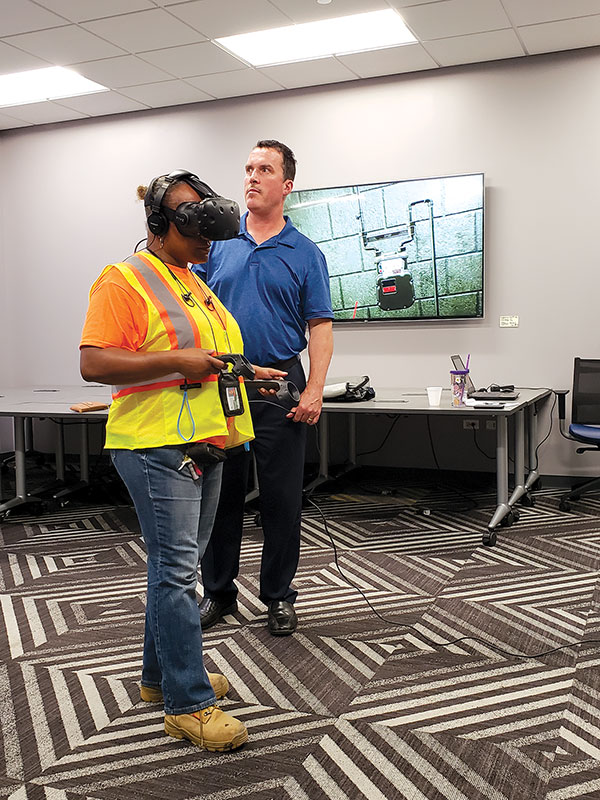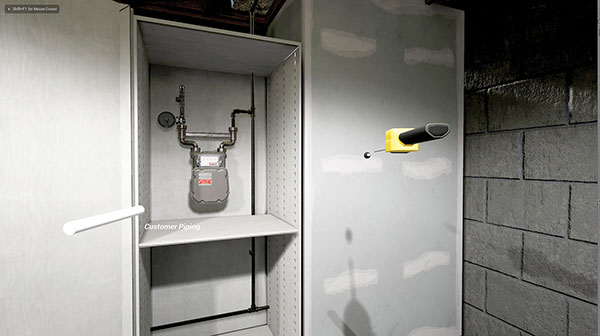October 2018, Vol. 245, No. 10
Features
The Future Arrives: Virtual Reality Safety Training
Spotlight on Utilities
By Michael Reed, Managing Editor
As is the case with other energy companies, local gas distributors place safety first when it comes to setting priorities and maintaining gas mains and other infrastructure. At the core of this effort is the frequent inspection of gas meters located at customers’ homes.
Gas meter safety and inspection training is one of the first, and certainly most important, aspects of preparing new employees to work in the field at gas companies. And while traditional methods have proved successful, some companies, such as Peoples Gas & North Shore Gas Company, which supplies natural gas to 830,000 residential, commercial and industrial customers in the Chicago area, have begun to explore virtual reality platforms to supplement training.
“The training we use is scenario-based virtual reality (VR) and concerns tasks associated with an inside safety inspection,” said Laura Budzinski, manager of Technical Training at Peoples Gas. “When you actually put it on, it’s like you are in a basement. You can hear the washer and dryer running. You walk up to the meter, you crouch down and look at it.”
With their virtual goggles in place, trainees embark on a virtual route where they can find both common and uncommon defects, in a surprisingly life-like, 3-D environment. A random set of 10 scenarios provides a different training experience for each user and provides analytics to monitor performance and accuracy. Observers can simultaneously see what trainees are experiencing on screen.
As currently configured, trainees also wear headphones during simulations and have a device similar to a laser pointer in one hand that allows them to “move around in the environment.” In the other hand they carry a gas detection instrument (GDI). (There is no smelling for natural gas odorant at the moment.)
“The simulation consists of anything someone might encounter out in the real world,” Budzinski said. “It’s supplemental to the initial inspection training that all employees receive. Once the training is completed, the users are able to use a gas-detection tool called a CGI to check for incorrectly identified gas leaks, visually inspect the meter number, identify things like tampering, and identify different stages of corrosion.”
Peoples Gas expects to begin using the virtual reality training platform, developed by PIXO VR, within the next few months to train for entry-level positions. Budzinski also sees the 3-D environment as a good way to help veteran employees brush up on their safety inspection skills.
To Budzinski, who has an engineering background, her own experience with the virtual training platform went well.
“It’s cool for the user, and I think that’s what really drives the engagement,” she said. “It’s very immersive, and people are really paying attention to what they are doing.”
One of the biggest attractions of the virtual platform for the company was the fact that 30% of the Peoples Gas workforce will be eligible to retire within the next few years.
“Because of the new workforce, there is definitely an increase in employees’ responsibility early on in their careers, which increases the need for consistency in training,” Budzinski said.
Also, in the area of training, Peoples Gas sees virtual training as something that could fit well with its ongoing partnerships with three Chicago-area high schools: Little Village Academy, Dunbar High School, and Fenger Academy High School. Through the company’s Utility Training Program, juniors and seniors learn about gas utilities in three phases: classroom instruction, experience-based assistance such as resume writing and actual training at the company’s facilities.
At the end of the program, if students do well in all three phases, they receive certification stating they are qualified to apply for entry-level positions. Budzinski said the company hired three students from the program this summer. Peoples Gas believes the virtual reality platform could be especially beneficial in the training of students.
“We thought using this new technology to help users practice in a controlled environment and give them total emersion would be a great way to evolve,” Budzinski said. “Virtual reality is experiential learning, and that results in greater trainee engagement and retention. It allows the user to experience more scenarios than can be set up in a practical setting as well, so there are multiple benefits.” P&GJ
“Spotlight on Utilities’ highlights innovations and achievements of those in the business of providing natural gas to homes and businesses. If you have a suggestion for inclusion in the column, email michael.reed@pgjonline.com







Comments